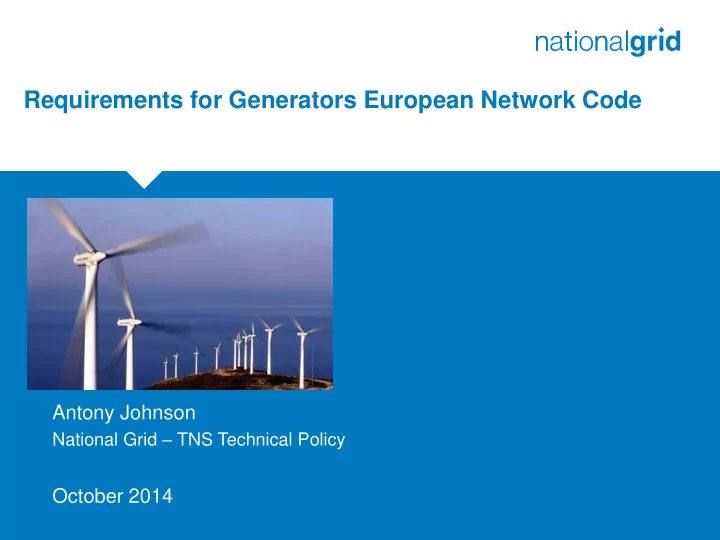

Requirements for Generators European Network Code Place your chosen image here. The four corners must just cover the arrow tips. For covers, the three pictures should be the same size and in a straight line. Antony Johnson National Grid – TNS Technical Policy October 2014
Overview Fault Ride Through Background to Current GB Structure Licensing and Connection Requirements Transitional Arrangements Structure Ways Forward Summary 2
Fault Ride Through GB Grid Code Working Group established to address fault ride through issues for Synchronous Generators – mainly focussed for very large directly connected Generators but also will consider smaller Generators The proposal is to consider early adoption of the RfG requirements but within the context of the GB framework Extensive study work completed and three options proposed Assessment still required for Generators to understand the impact in terms of their auxiliary supplies Fault Ride Through requirements for Smaller Embedded plant has not yet been considered but the issue has been discussed and the initial view is that Type B, C and D Generators which are Embedded should satisfy the fault ride through requirements for Transmission System faults only not at the Connection point as currently proposed in RfG. 3
Where do the Codes come from European Legislation UK Legislation Electricity Act 1989 European Network Codes Utilities Act 2000 (from 2014) C11 Energy Act 2011 Electricity Ten Year Statement C4 System Charging Transmission C6 Licence Connection Charging B12 C3 C10 C14 STC BSC CUSC Grid Code Transmission Distribution Generation Licence Supply Licence Licence Licence 4
Applicable Requirements and Agreement Type These are influenced by The requirements of the Industry Codes Licensing Requirements Size of Generator (Large, Medium or Small) Point of Connection Transmission Area to which the User is connected Is the Generation Directly Connected or Embedded 5
The Effect of Licensing Administered by DECC Mandatory requirement for any Generator in excess of 100MW – Penalties apply without a Generation License. In England and Wales Licence Exemption is available between 50 – 100MW No License is required below 50MW in England and Wales The current Licensing arrangements complement the existing definitions of Large, Medium and Small Power Stations Under RfG, the adoption of Type A, B, C and D Generators only without reference to Small, Medium and Large is likely to require a review of the Licensing requirements 6
Applicable Requirements Some Examples – England and Wales Size Embedded or TO Area Agreement TEC Metering Applicable (MW) Directly Type Industry Codes Connected 100 Directly NGET BCA Yes CVA CUSC (Large) Connected Grid Code BSC 150 Embedded NGET BEGA Yes CVA CUSC (Large) Grid Code BSC 99.9 Embedded NGET BEGA Yes CVA CUSC (Med) Grid Code BSC DCUSA D Code G59 LEEMPS No SVA DCUSA D Code G 59 Grid Code (Part) 49.9 Embedded NGET None No SVA DCUSA (Small) D Code G59 7
Applicable Requirements Some Examples – Scotland Size Embedded TO Area Agreement TEC Metering Applicable (MW) or Directly Type Industry Codes Connected 100 Direct SPT BCA Yes CVA CUSC (Large) Grid Code BSC 30 Direct SPT BCA Yes CVA CUSC (Large) Grid Code BSC 10 Direct SHE-Trans BCA Yes CVA CUSC (Large) Grid Code BSC 50 Embedded SPT BEGA Yes CVA CUSC, Grid (Large) Code, BSC, DCUSA, D Code. G59 BELLA No SVA DCUSA, D Code, G59 9.9 Embedded SHE - Trans None No SVA DCUSA, D Code (Small) G 59 8
Transitional Arrangements At the September meeting an action was raised on the implications for impending Generator Connections who could be seeking a connection in the immediate future which will overlap the RfG implementation phase Discussed with NGET Legal Requirement to identify:- Who the current applicants are and Who could be affected by the ENTSO-E RfG Code Requirement to develop generic wording either through the covering letter of a connection offer, through a generic Code change or via NGET’s website The process is complicated by existing Users who may choose to Mod App. An arrangement to manage this process needs to be developed . 9
Transitional Arrangements - Example Assume Comitology is finalised on 1 st January 2015 and the GB Codes need to be aligned by 1 st January 2017 A Generator also applies for a connection on 1 st January 2015 with a completion date expected on 1 st January 2019 with major plant items expected to be procured in February 2017 and hence will be caught by the ENTSO-E RfG Requirements NGET will need to issue an offer by the end of March 2015 but at the time of the offer the Grid Code and Bilateral Agreement will not have been updated to capture the RfG Requirements. The Offer will need to refer to the approved version of the RfG and current Grid Code with some potentially significant amendments to the Technical Appendices within the Bilateral Connection Agreement. At this stage however the exact technical requirements would be uncertain. A similar issue will arise for Modification Applications – ie Generators who already have a connection offer / agreement This will be particularly challenging to manage in the early phases of the transition process 10
Transitional Issues / Ways Forward Uncertainty over national parameters Eg National Grid can suggest and recommend National Parameters but these need to be subject to industry Governance which could be a time consuming process especially for new technical requirements Significant potential uncertainty for Generators in specifying equipment Identify preferred Structure Option Start limited legal drafting to ensure the structure will work – but recognising this is an iterative process Similar issues have been encountered previously but to a lesser extent Technical Requirements for Wind Generation – 2005 Offshore Transmission - 2009 11
Summary Fault Ride Through developments Review of GB Connection Process Impact of Licensing Complexities of Transition Transitional Issues / Ways forward 12
Useful links ENTSO-E https://www.entsoe.eu/resources/network-codes/ ACER http://www.acer.europa.eu/portal/page/portal/ACER_HO ME/Activities European Commission http://ec.europa.eu/energy/index_en.htm JESG http://www.nationalgrid.com/uk/Electricity/Codes/systemc ode/workingstandinggroups/JointEuroSG/ 13
Questions 14
Recommend
More recommend